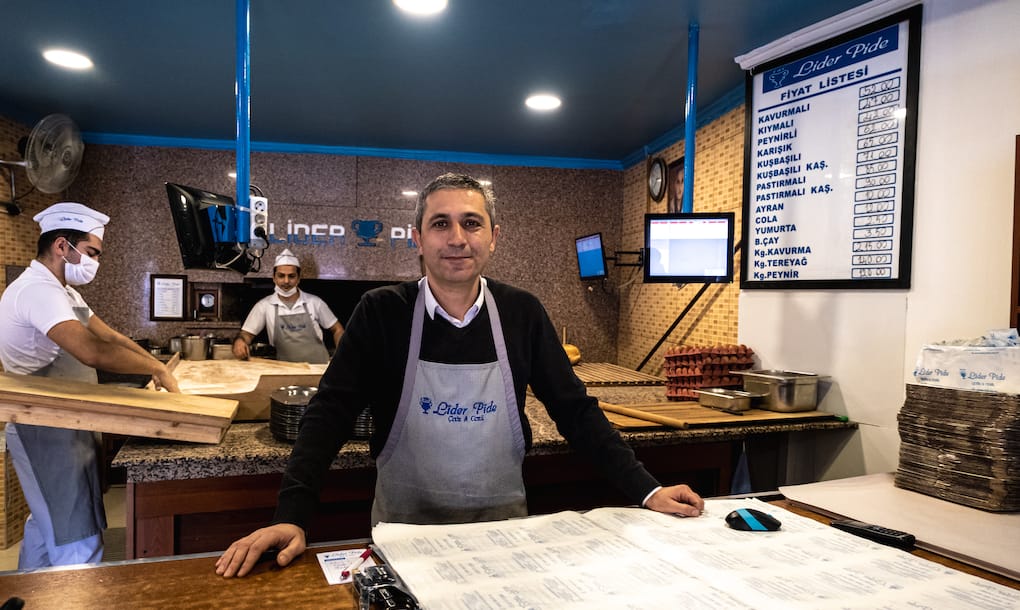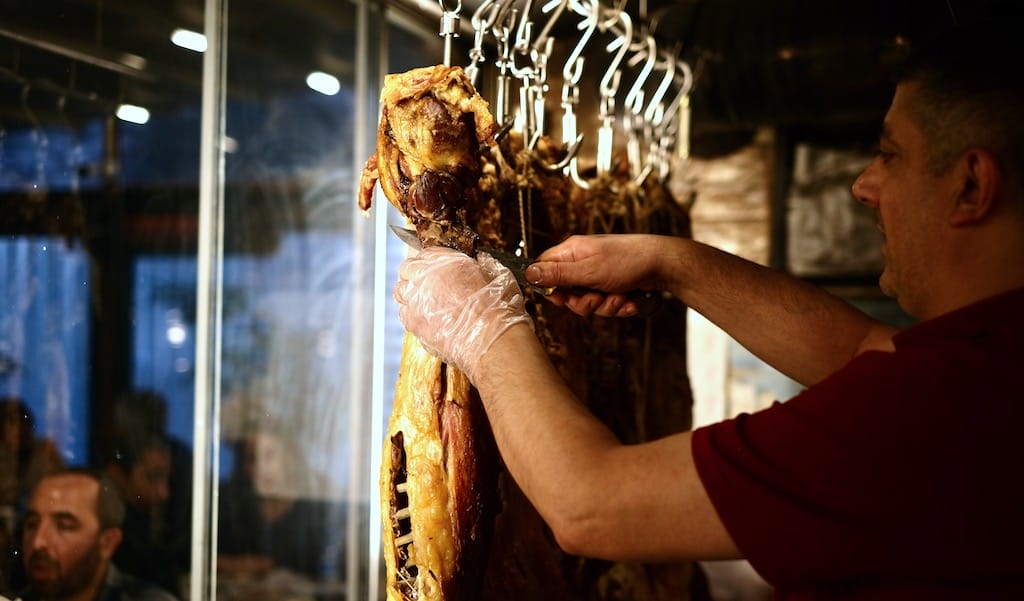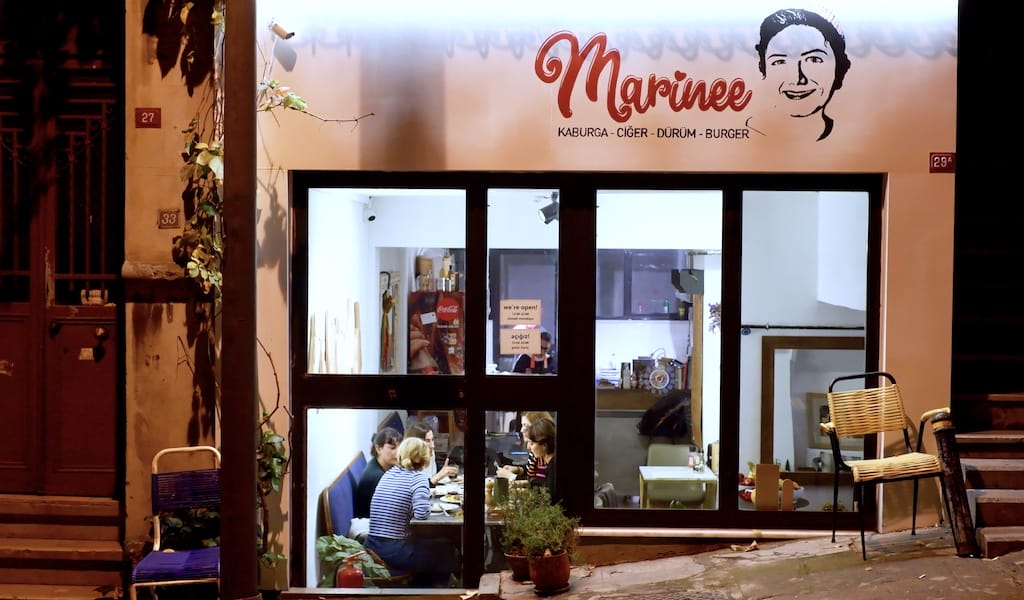Before we cross the Bosphorus Strait to Asia, this story starts on Istanbul’s European side, at a small stand that has been operating in Beyoğlu since the mid-1970s. There, Muammer usta serves up expertly-cooked and sliced cuts of kelle söğüş (chilled lamb’s head meat), perched in a strategic location across from the local fish market and a stone’s throw from the Nevizade strip of meyhanes and bars. Over the decades, Muammer usta has become one of the most recognizable characters in the area.
The usta’s influence cannot be overstated. His stand is beloved by locals, foreign tourists from across the globe and food critics alike. And in March of this year, the pull of his master craft drew two longtime friends and fans to open Kadıköy Kelle Söğüş Muammer across the Bosphorus in the heart of the buzzing Kadıköy district. Yuji Umezu and Savaş Sekizkardeş, both Kadıköy residents, met at the kindergarten their daughters were attending. Though at first they seem an odd pair for such an esnaf trade – Yuji, from Amsterdam, has a Japanese father and an Armenian mother with Anatolian roots, and Savaş from the southeastern Turkish province of Mardin, spent five years working a number of service sector jobs in South Africa, where he moved to learn English – their story is a common one in the melting pot that is Istanbul.
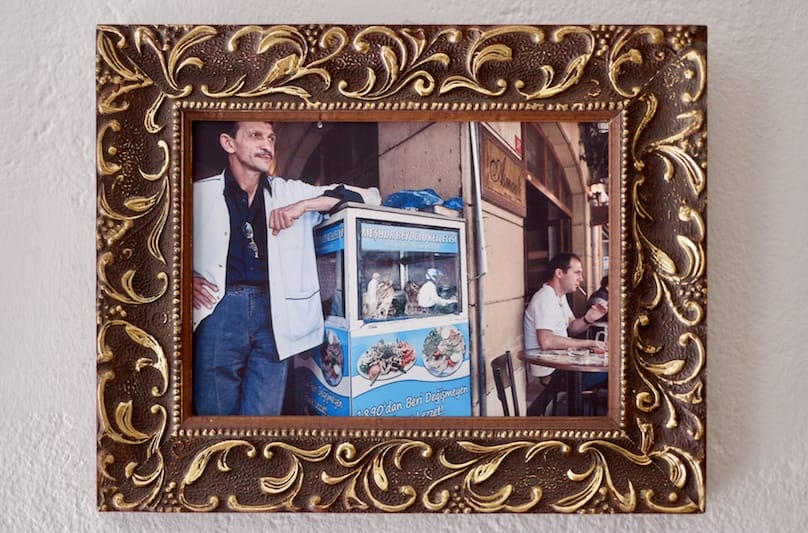
Yuji recounts his first experience with kelle söğüş, which he had originally written off as a “scary food.” A friend brought him to Muammer usta’s stall and introduced the two. “It was hard to have a bite from the sandwich in the beginning,” he says. But that was seven or eight years ago, and he is now enamored with the dish – which consists of sliced cheek, tongue and eye fat. Yuji became a regular of Muammer usta’s, and this developed into a tight-knit friendship. He became a sponge, listening to Muammer usta and absorbing everything he had to say. Eventually, he and Savaş found themselves wanting to prepare their own kelle söğüş, so they began interning for the beloved Beyoğlu stand. “Before even starting this and looking for a location, that’s where we learned everything, and that’s how we understood how disciplined that family is in preparing this type of street food,” Yuji said of his time working closely with Muammer and the usta’s son Mustafa and son-in-law Hüseyin, adding that they ate kelle every single day (that is, if the customers hadn’t bought up their daily supply already).
While at first glance kelle söğüş is not for the faint of heart (whole lamb heads usually would adorn Muammer usta’s compact cart), the dish is rewarding for those who dare try it. The demanding process in which the meat is cooked – first boiled and then chilled – imparts a rich and smooth flavor that is neither gamy nor pungent. The usta himself insists that kelle söğüş does not belong in the sakatat (offal/organ meat) category, but is in a special league of its own.
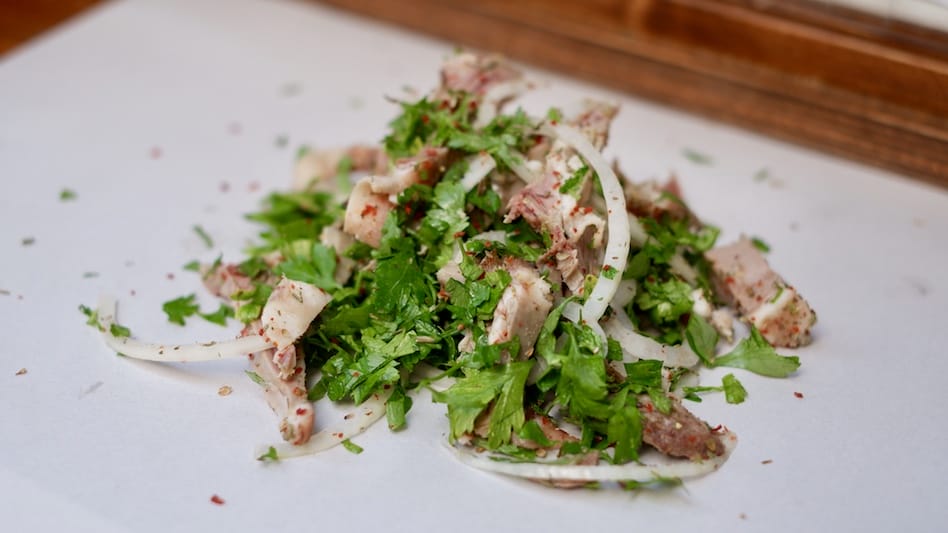
Not only is kelle söğüş remarkably exquisite and complex, it’s also a special regional variety that Muammer’s family has been preparing for four generations, since 1890. The family hails from the central Anatolian province of Niğde, which was once home to a thriving population of Karamanlides, Orthodox Christians who spoke Turkish but wrote in the Greek alphabet. Muammer usta’s ancestors learned their trade from the Greeks in two small villages of Niğde, carrying on the tradition after the Greeks in the area were forcibly uprooted and sent to Greece during the population exchange of 1923. The dish apparently failed to make it to present-day Greece, so Muammer usta’s family – and now Yuji and Savaş – have effectively preserved a centuries-old Greek tradition that otherwise would have been lost.
While the duo are preparing the same lamb heads that Muammer usta and his family cook to perfection, they assure us that longtime customers will know if any small detail is askew.
Niğde-style kelle söğüş is markedly different from the more widespread İzmir kelle söğüş (though the latter is also said to have its roots in Niğde). Aficionados of Niğde kelle söğüş will argue that the İzmir version is inferior and that the extra spices (cumin) and toppings (brain, red onion, tomatoes, green pepper) are used to mask the flavor of otherwise inferior-quality meat. While traditionally served on a plate, Muammer “Istanbulized” the dish decades ago when he started serving the kelle söğüş sandwich-style in a freshly-baked half-loaf of bread.
It was no small gesture for Muammer usta and his family to bring Yuji and Savaş into the fold, but it was a decision that Muammer usta made quickly, owing to the years of trust developed between the three. “They’re not really open to letting anyone step into their industry after three or four generations,” Yuji tells us. This has quickly made an impact on the current customer base of the Kadıköy cart. “More than 70 percent of our customers are regulars of Muammer usta, but happen to live in this area,” he says. “Some of them know him better than we do, and you can imagine the pressure of serving those types of customers.” But he and Savaş feel that the feedback from loyal customers has been invaluable, even if it just involves minor issues with the salt or spice levels. While the duo are preparing the same lamb heads that Muammer and his family cook to perfection, they assure us that longtime customers will know if any small detail is askew.
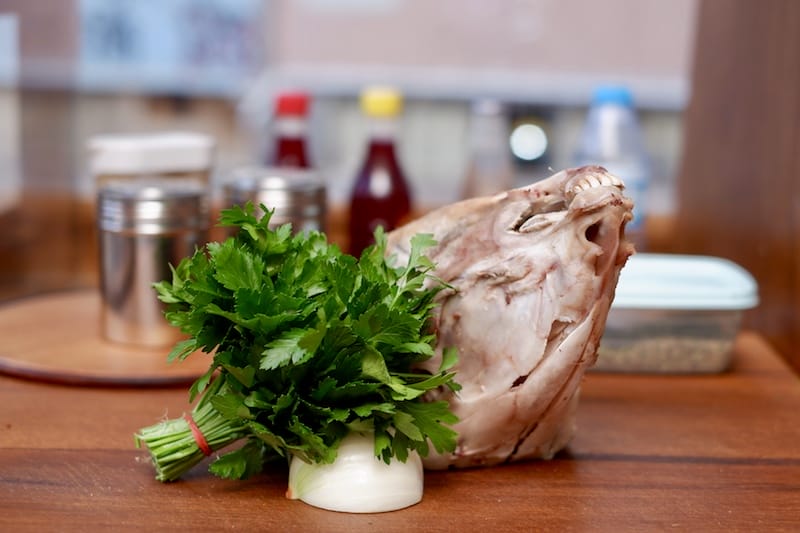
Though the pair, together with Muammer’s relatives, would eventually like to expand, their primary focus is sustaining his brand, replicating the same taste and maintaining the loyal customer base. “He has one very, very difficult objective to achieve – you can’t be him,” Yuji explains. “Muammer usta has a smile every time you visit. He’s passionate about what he does. He has stories and a lot of details connected to selling kelle here in Turkey. So that’s why we decided not to open our own kitchen in phase one over here, but to work together in preparing the lamb heads.” In fact, when Muammer usta’s stand gets overwhelmed with business, the pair cross the Bosphorus to give him a hand with cooking and prep. “They’re really busy. They sell at least 30 or 40 heads a day. So when he needs help and we are available, we go.”
But business is bustling over in Kadıköy for Yuji and Savaş as it is. The pair took a huge risk in abandoning their careers to set up a new place in a restaurant sector that was struggling even before Covid-19 hit, but they have already broken even as of this summer. This is no doubt a success by restaurant industry standards, particularly during a pandemic. “We’re learning by doing. We’re going through a whole trial and error experience right now and it is a wonderful journey. When Savaş and I decided to do something together, we got out of the corporate life so it was also more of a philosophical kind of decision,” Yuji says. Before opening their stand, Savaş had returned to Turkey from South Africa and was working in the automotive industry for a long stretch, and Yuji spent the last decade in the country doing everything from running an art gallery to working in the corporate side of the aviation sector.
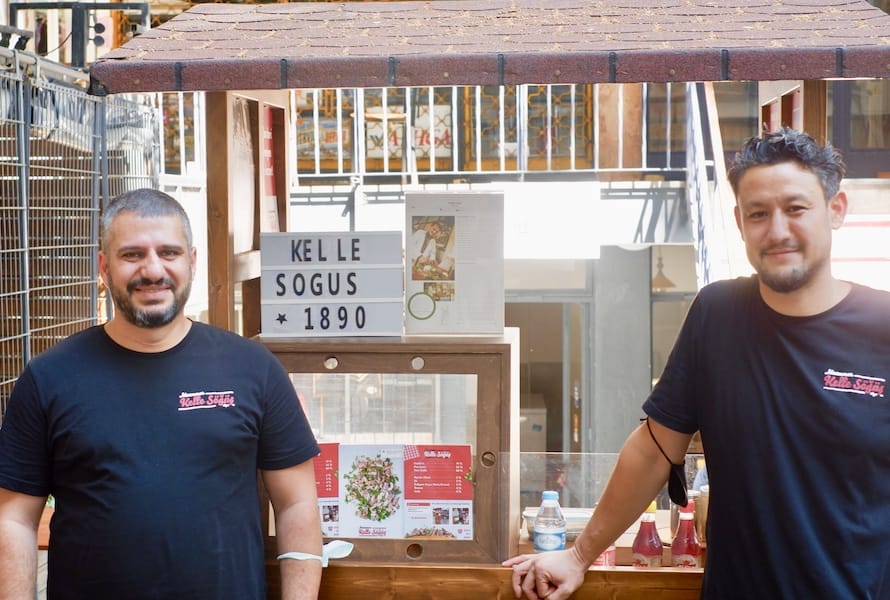
As for Muammer usta, though his health has prevented him from manning his stand every day, his legacy is in no danger of fading away as his son and son-in-law continue to carry the torch. The small chairs and tables situated around his cart were packed with diners on a recent day in July, as Beyoğlu has been crowded and surging with energy after curfews were lifted and bars opened up for the first time since March 2020. In taking the same brand, expertise and taste to Kadıköy, Yuji and Savaş are also playing an important role in keeping alive a tradition that spans centuries, abandoning more lucrative careers because of their dedication to a much less glamorous line of work. In an Istanbul where small tradesmen and iconic street vendors face the banal obstacles of gentrification and mass production, the city would be so fortunate to have more people bravely pursuing their humble path.
 April 25, 2022 Lider Pide
April 25, 2022 Lider Pide
Roaming the streets of Istanbul at 8:30 a.m. on a Sunday can be a surreal experience. […] Posted in Istanbul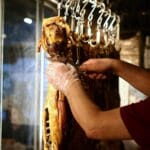 February 2, 2022 Meat Palaces
February 2, 2022 Meat Palaces
Ask anyone from the Eastern Turkish city of Bitlis where büryan kebabı comes from, and […] Posted in Istanbul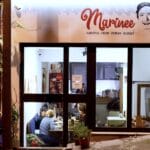 January 11, 2022 Marinee Kaburga
January 11, 2022 Marinee Kaburga
“I don't want to die, because I just can't get enough of Istanbul,” proclaims Mari […] Posted in Istanbul
Published on August 04, 2021
Related stories
April 25, 2022
IstanbulRoaming the streets of Istanbul at 8:30 a.m. on a Sunday can be a surreal experience. The sun is shining, the seagulls are bellowing as they dip and dive – but the normally bustling streets are quiet. A few shops might be lifting their shutters, and cafés in younger neighborhoods may only just be putting…
February 2, 2022
Istanbul | By Erin O’Brien
IstanbulAsk anyone from the Eastern Turkish city of Bitlis where büryan kebabı comes from, and they’ll proudly tell you that the slow-cooked meat dish hails from none other than their hometown, near Lake Van. Pose the same question to folks from Siirt, just 100 km south, and they’ll insist anyone making it from a city…
January 11, 2022
Istanbul“I don't want to die, because I just can't get enough of Istanbul,” proclaims Mari Esgici, chef and owner of Marinee Kaburga, a small, cozy restaurant specializing in beef kaburga (ribs) and brisket that is a delightful addition to the Kurtuluş neighborhood's culinary patchwork. Hailing from an Armenian family with roots in the southeastern city…















































